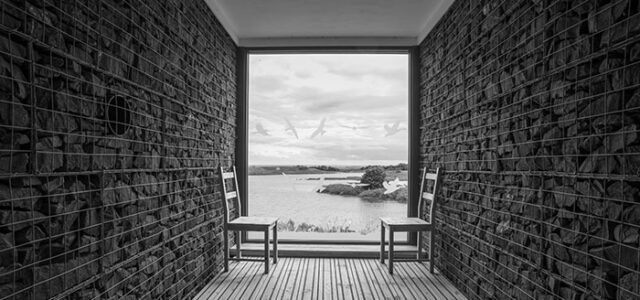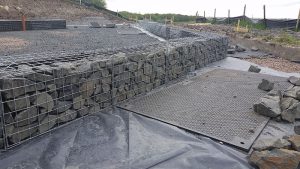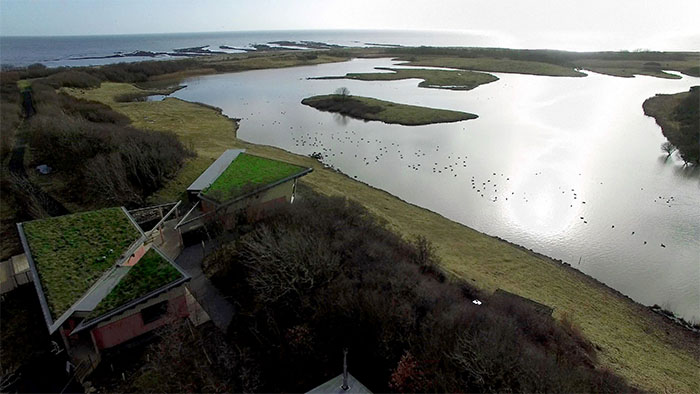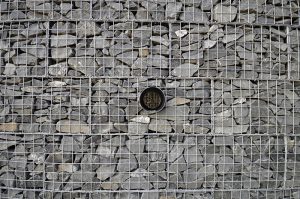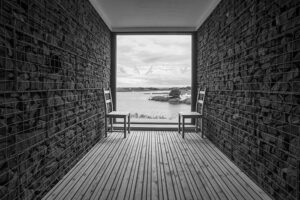
Galvanized gabions were chosen as the key foundation link structure for this project as they were ‘fillable’ by the volunteer workforce – the central corridor is a tour-deforce – and moveable by a single person. They also accommodate movement as the whole strategy of the structural design was one of adaption to the complex brownfield site.
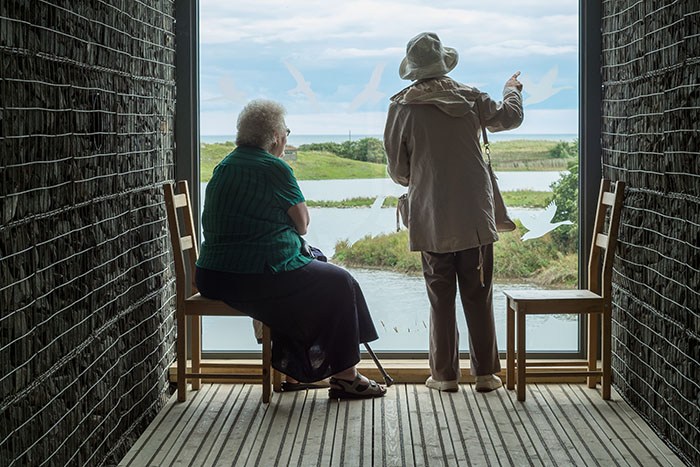
The galvanized solution in this location gave a cost efficient solution that was both humble, light in transport to site, suitable for the location for the longevity of the building, and adjustable and easily touched-up as Brightblue Studio required.
Galvanized gabions were also used to create the principle axis corridor which directs the attention into the reserve and orientates the visitor to the different spaces off and along the axis.
As with many elements of this award winning ecological building, Brightblue Studio wanted to show it was possible to produce extraordinary architectural interest with a non skilled workforce and widely accessible and affordable components.
“Total pride in being part of such a project that I could never have envisaged becoming involved with a few years ago.” Volunteer
Galvanized gabions have not been used before in the UK as primary structural component in a building. The structural engineer utilised the experience of Haiti post the 2010 earthquake where they used gabions to rebuild fashioned out of post earthquake materials (concrete lumps and rebar) to partly justify the use of the galvanized gabions in this structure.
The Project has won a number of awards:
- RICS NATIONAL AWARD 2018 – COMMUNITY BENEFIT – Runner up
- GREEN APPLE AWARD 2018 FOR SUSTAINABLE CONSTRUCTION
- RIBA NORTH EAST AWARD WINNER 2018
- RIBA NORTH EAST SUSTAINABILITY AWARD WINNER 2018
- RIBA NORTH EAST CLIENT OF THE YEAR 2018 for Northumberland Wildlife Trust
- RICS NORTH EAST AWARD 2018 WINNER – COMMUNITY BENEFIT
- LABC NORTHERN AWARD 2018 WINNER – BEST PUBLIC SERVICE BUILDING
Henry Amos on winning a Sustainability Award
Overview of Project
The four clear aims and achievements of the wider Dynamic Druridge project were to inspire and engage people about nature, to build the new Sustainable Wildlife Discovery Centre and to recreate and reconnect habitats to increase biodiversity. Located on the North East Coast, the site is on the Hauxley Nature Reserve which was an old open cast mine.
The impacts, identified in the HLF Evaluation (HLFE), summarised: “The Wildlife Discovery Centre is unique, bespoke, exceptional, amazing, spectacular and remarkable.”
Northumberland Wildlife Trust is an environmental charity dedicated to protecting wildlife and habitats within Northumberland, North Tyneside and Newcastle and connecting people with nature to promote greater well-being.
Brightblue Studio is a hybrid Art Architecture company passionate about delivering innovative, sustainable and creative projects through collaboration. For this project, they developed Design and Build capacity, delivering all project, cost, H&S and on-site management.
Funded through NWT, 17 partners and the HLF, and with 111 volunteers giving more than 26,000 hours the outcomes were broader than the building:
Costing £610K without fees, for 300msq internal of 2 interconnected buildings is “remarkable value for money” for “arguably the greenest building in the North East”. HLFE
During the build there were more than 50 events attended by more than 4200 people, 92% of whom were inspired by the project. Rated 4.8* Google, and 4.5* Trip Advisor, 100% of visitors would recommend the Discovery Centre to a friend. Visitor numbers are twice the targets, with a massive surge of 106 new members with a new wildlife group and a programme of events.
Henry Amos about Hauxley Wildlife Discovery Centre
The Wildlife Discovery Centre, built from the landscape, in the landscape, provides a hub for interpretation, learning, café and orientation, new Natural Play area and entry to the new fully accessible reserve:
“It is a pleasure to visit somewhere where the accessible route really is accessible. I could look around me whilst using my wheeling aid instead of looking at the ground.” Visitor
It is proving to be one of the best wildlife-watching locations in the North East, working as a signpost to 4 other local wildlife reserves. In addition, on the “Coastal Tourism Path” it acts as an attraction and information hub for other local tourism destinations, ‘staycations’ and activities such as the Puffin Festival and Coquet Island visits and as a catalyst for additional services.
Comments on the Trip Advisor range from “best nature reserve ever”, “stunning and relaxing” and “paradise found” to “brilliant new visitor attraction” and “wonderful place that will only get better”.
The reserve now has an additional 6800 trees, 1300m of hedgerow habitat, refurbished hides and control over the water level to improve habitat management. The Trust is encouraging education across community wide groups at all times of the year.
“It provides an exceptional visitor experience which delivers the original vision of a wildlife watching destination for all.” HLFE
The whole building opens up to the site – lifting roof lines to the sides embracing the reserve, gently referencing a bird in flight with a nod to motion with sequential roofs. The open axis core of the building takes people into the landscape, into nature. This continues through viewing portals, picture windows, a dynamic plan shape with the innovative straw bale angles and art works to be discovered by the visitor.
The Centre is two buildings with the decked space between creating learning spaces and marking the beginning and end of the route around the reserve. Sitting astride the ‘High Wall” of the old open cast mine challenged the structural solutions through unpredictable settlement. The team developed an innovative solution to the problem. The foundation solution was informed by developments in Haiti after the earthquake, and is potentially a powerful strategy for use in constructions where low embodied energy, and minimal plant use is required.
“The Discovery Centre sits beautifully and harmoniously within the landscape. It is a modern build but it uses organic materials in a way which lend themselves to the feel of the place as a whole” – Simon King OBE.
Zero concrete construction minimises embodied energy and legacy problems opting for flexible constructions and local supply of major build elements to minimise transport energy; layered ‘hoggin’ foundations; galvanised gabion structure with local quarried stone; load bearing strawbale in ‘world first’ dynamic 45 and 135 degree plan shapes; self healing lime render; inherently antiseptic lime wash; huge earth floors from local supplied clay soil; more than 80% recycled content breathable internal wall-boarding; structural timber in the round (on large single Whinstone footings) and sawn boarding from Trust grown Douglas Fir. All topped with a habitat conserving meadow roof. During construction, waste was segregated into that to be re-used on site and then to recycling at central facilities.
This creates peaceful calm spaces in which multiple activities can occur supported by solid green principles made real: Biomass heating from on site renewable resources or pellets, SBEM A rated, the building has no eco-bling but plenty of thermal mass, thermal insulation, passive solar gain design, self made straw board based sound insulation ceilings, LED lighting and red light for night use, heat recovery ventilation and on site sewage treatment. Long term the project will increase diverse habitat, access and facility, and Phase 2 offers double the space. Changing uses inside can be easily facilitated through flexible systems through easy access integrated service trays. When it comes to the end of its life, the building can be recycled or mostly blend back to being earth.
“The Wildlife Discovery Centre is transformational for the Trust and it redefines our relationship with our members, the public and volunteers.” Mike Pratt NWT Chief Executive.
Images © John Faulkner, Brightblue Studio, Northumberland Wildlife Trust, Simon Greer

